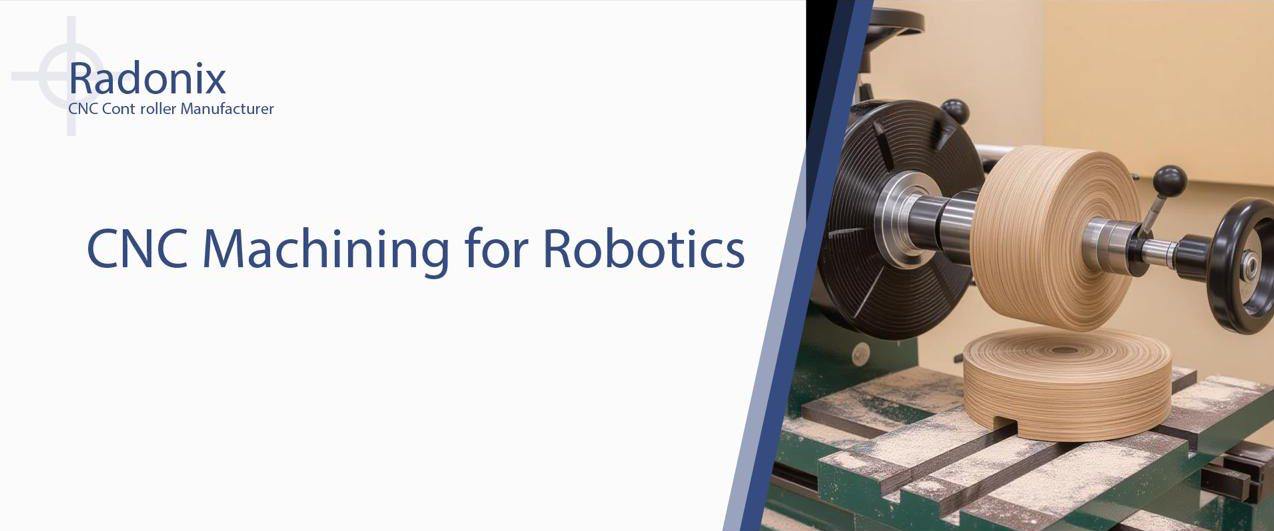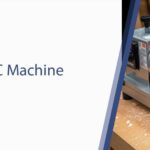At Radonix, we engineer high-performance CNC controllers like the PC-Smart (fifth-generation) and PC-Pro LAN (fourth-generation), integrated with Cam-Pro CAD/CAM software and specialized interfaces for woodworking, metal processing, and now increasingly for robotics components.
In September 2025, following the successful Q1 rollout of our sixth-generation open-source, cloud-based controllers, Radonix is at the forefront of enabling precise machining of robotic parts— from lightweight frames to intricate joints.
If you’re querying CNC machining for robotics, this article delivers comprehensive answers: What role does CNC play in robotics?
What are the 2025 trends? How can SMEs implement it affordably? We’ll cover fundamentals, benefits, applications, Radonix integrations, step-by-step guides, and future outlooks.
By leveraging Radonix’s multi-axis controllers (up to 6 axes) and AI-enhanced features, you can achieve sub-micron precision, reduce production costs by 30-40%, and accelerate time-to-market in robotics manufacturing. Let’s delve into how CNC machining is revolutionizing robotics—and why Radonix is your ideal partner.
The Role of CNC Machining in Robotics Manufacturing
CNC machining for robotics involves using computer numerical control to fabricate parts with exceptional accuracy, essential for robotic systems where even minor deviations can cause failures.
Unlike additive methods like 3D printing, CNC subtractive processes excel in producing durable, high-strength components from metals (aluminum, titanium), composites, and polymers.
Key processes include milling for structural frames, turning for shafts, and drilling for sensor mounts.
In 2025, CNC’s integration with robotics is bidirectional: CNC machines robotic parts, while robots automate CNC operations (e.g., cobots for loading/unloading).
Radonix’s PC-Smart controllers support hybrid setups, with high-pulse outputs (500,000 pulses/second) ensuring smooth, vibration-free machining critical for robotics’ precision needs.
For instance, our XYZ Router TC interface handles complex geometries in robotic arms, while cloud connectivity enables real-time data sharing for design iterations.
Core elements:
- Material Versatility: Handles advanced materials like carbon fiber composites for lightweight exoskeletons.
- Tolerance Control: Achieves ±0.005mm, vital for joint assemblies.
- Scalability: From prototypes to mass production, with multi-axis capabilities for 5D/6D paths.
As per emerging trends, CNC robotics combines CNC accuracy with robotic flexibility, enabling adaptive manufacturing.
Benefits of CNC Machining for Robotics Applications
Incorporating CNC machining in robotics offers transformative advantages, especially amid 2025’s focus on AI-driven optimization and sustainability.
Unmatched Precision and Quality
Robotics demand parts with tight tolerances; CNC delivers repeatable accuracy, reducing assembly errors by 50%. Radonix’s closed-loop configurations in PC-Pro LAN minimize backlash, ideal for machining gears and linkages.
Cost-Effective Production
SMEs benefit from lower tooling costs and rapid prototyping. With Radonix Cam-Pro, optimize tool paths to cut material waste by 25%, aligning with eco-trends in robotic manufacturing.
Flexibility and Customization
CNC allows quick design changes via software updates. Our open-source sixth-gen controllers enable custom integrations, supporting AI for adaptive machining in robotics R&D.
Enhanced Durability and Performance
Machined parts withstand high loads; for example, CNC-turned titanium joints extend robotic lifespan by 30%.
Integration with Automation
2025 sees cobots rising in CNC shops; Radonix facilitates this with Ethernet-enabled remote monitoring, boosting lights-out operations.
Table of Benefits:
| Benefit | Description | Radonix Enhancement | 2025 Impact |
| Precision | Sub-micron tolerances | Closed-loop feedback | 50% fewer errors |
| Cost Savings | Reduced waste and tooling | AI path optimization | 25-40% lower costs |
| Flexibility | Rapid iterations | Open-source customization | Faster prototyping |
| Durability | High-strength materials | Multi-axis support | Extended part life |
| Automation | Cobot integration | Cloud remote access | Lights-out efficiency |
These align with trends like AI-powered process optimization and hybrid manufacturing.
Key Applications of CNC Machining in Robotics
CNC’s versatility shines in robotics, from consumer drones to industrial automation.
Structural Components
Milling robotic frames and chassis from aluminum for lightweight strength. Radonix’s XYZ Plasma interface excels in cutting complex profiles.
Joints and Actuators
Turning precise pivots and bearings. Our XZA Wood Turning adapted for metals ensures concentricity.
End-Effectors and Grippers
Drilling and engraving custom tools. Cam-Pro’s 3D simulation prevents defects in intricate designs.
Sensor Housings
Machining enclosures for LiDAR or cameras, with tolerances for alignment.
Prototyping and Customization
Rapid fabrication for bespoke robots, like in medical exoskeletons.
In 2025, multi-axis CNC expands to 5-axis for undercuts in robotic limbs.
How Radonix Elevates CNC Machining for Robotics
Radonix’s ecosystem is tailored for robotics machining challenges.
Advanced Controllers
PC-Smart series with 6-axis support handles helical paths for screw threads in actuators.
Cam-Pro Software
CAD/CAM integration generates optimized G-code, with AI nesting for batch production of robotic parts.
Cloud and IoT Features
Sixth-gen controllers offer predictive maintenance via digital twins, reducing failures in high-duty robotics.
Specialized Interfaces
Over 30 options, like CNC GOLD for precision engraving on robotic sensors.
Sustainability Focus
Energy-efficient designs cut consumption by 20%, supporting green robotics trends.
Step-by-Step Guide to CNC Machining Robotic Parts with Radonix
Implement CNC machining for robotics efficiently with this roadmap.
Step 1: Design and Material Selection
Use CAD for part modeling; select alloys for strength. Import to Cam-Pro.
Step 2: Tool Path Planning
Define operations: Roughing at 200 mm/min, finishing at 150 mm/min. Simulate for collisions.
Step 3: Controller Setup
Connect PC-Smart via Ethernet; set parameters for multi-axis.
Step 4: Machining Execution
Load G-code; monitor remotely. Use closed-loop for real-time adjustments.
Step 5: Quality Inspection
Post-machining checks with integrated probes.
Step 6: Iteration and Scaling
Analyze data; optimize for production.
Pitfalls: Overlook material expansion—use Radonix’s thermal compensation.
This process, per benchmarks, shortens cycles by 40%.
2025 Trends in CNC Machining for Robotics
2025 highlights include:
- AI-Driven Machining: Real-time optimizations.
- Cobots and Automation: For unmanned operations.
- Advanced Materials: Composites for lighter robots.
- Digital Twins: Virtual testing.
- Sustainability: Eco-friendly processes.
- Cybersecurity: Protecting connected systems.
Radonix’s seventh-gen (2026) will incorporate quantum-inspired optimizations.
Real-World Case Studies: Radonix in Robotics
A robotics startup used Radonix for machining drone frames, cutting prototypes from weeks to days, saving 35% costs.
Conclusion
CNC machining for robotics is key to 2025’s innovations, and Radonix provides the precision tools to succeed. From multi-axis controllers to AI software, elevate your manufacturing.
Contact Us:
- E-Mail: info@radonix.com
- Phone: +90 (553) 920 5500








